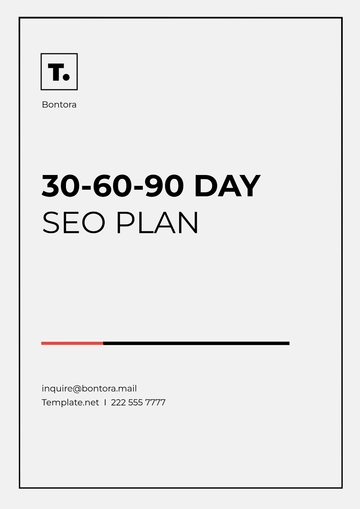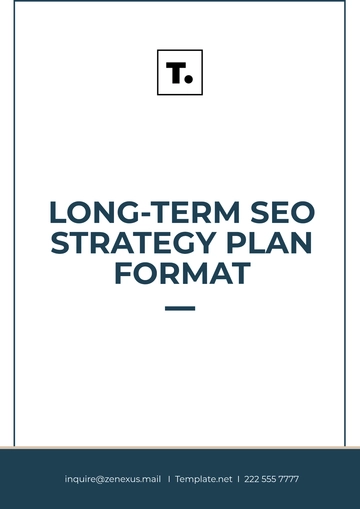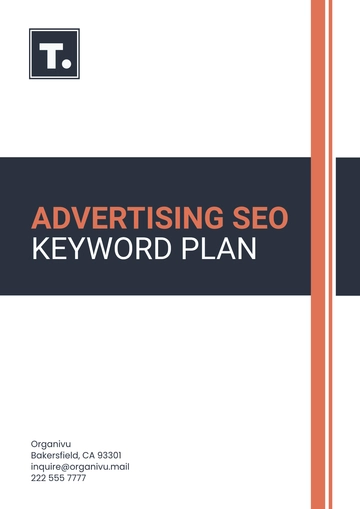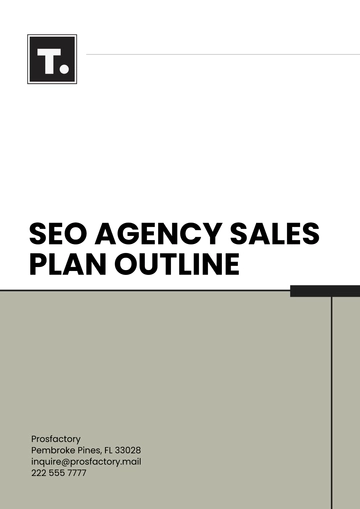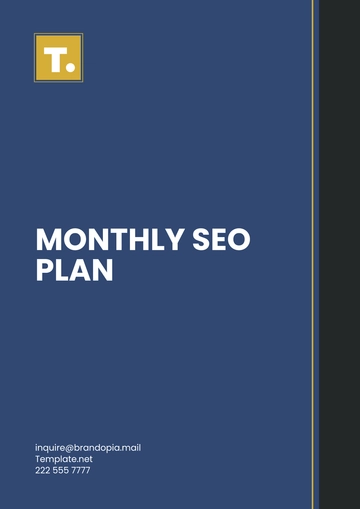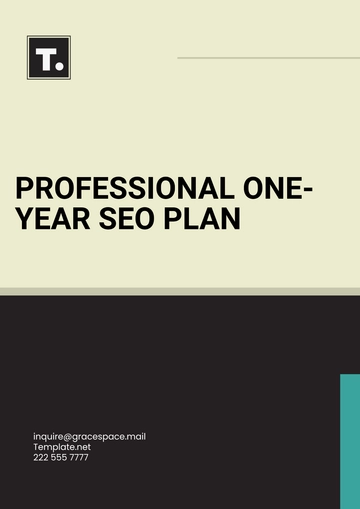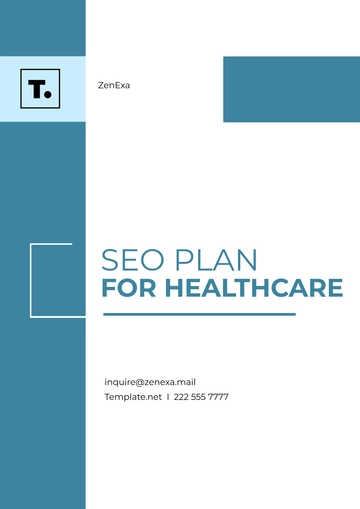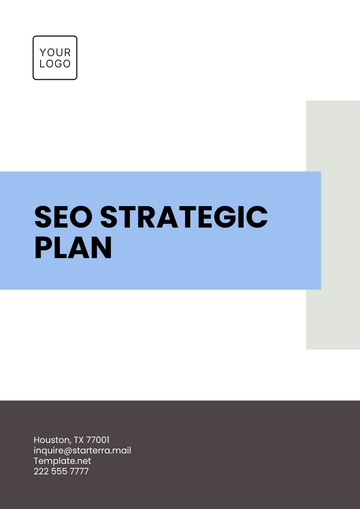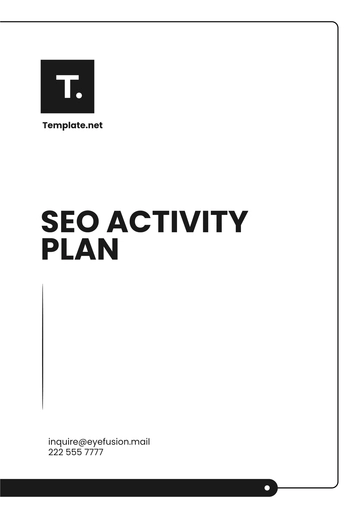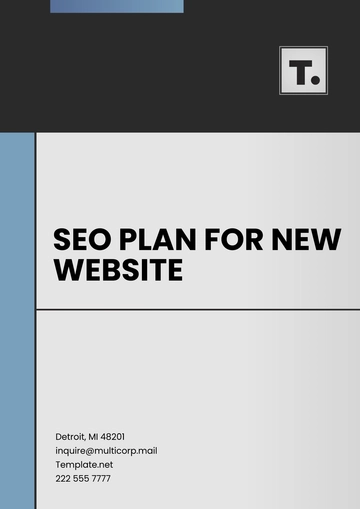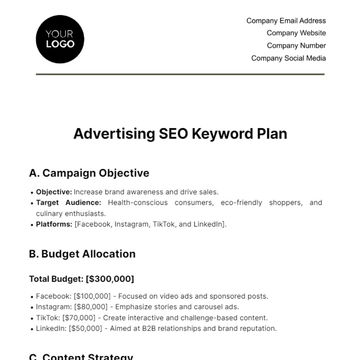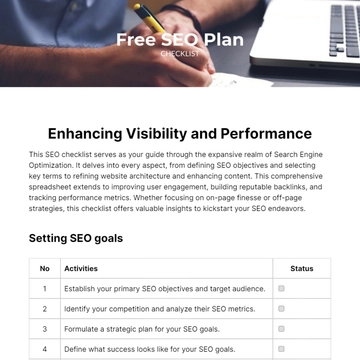Free SEO Plan For Healthcare
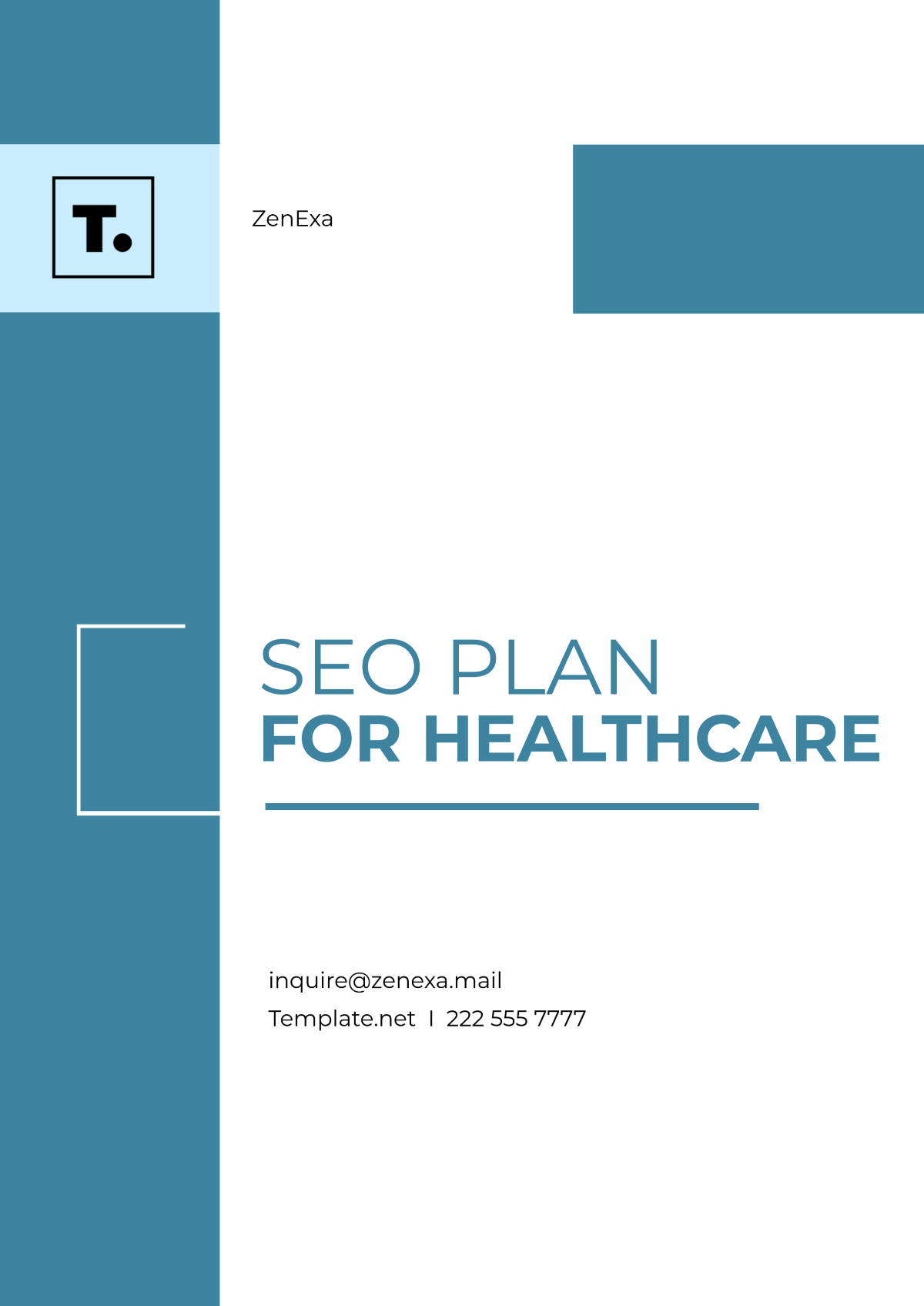
I. Executive Summary
This SEO plan is developed to enhance the local search visibility of [YOUR COMPANY NAME]. Our objective is to attract more patients from the specific geographic areas of San Francisco, CA by implementing effective SEO strategies. The plan outlines detailed actions and optimizations necessary to achieve this goal.
II. Objectives
A. Increase Local Search Rankings:
Achieve top 3 rankings for primary keywords.
Improve rankings for secondary and long-tail keywords.
B. Improve Website Traffic from Local Searches:
Increase organic traffic by 30% within six months.
Reduce bounce rate by enhancing user experience.
C. Boost Patient Acquisition:
Increase appointment bookings by 20% from the San Francisco area.
Enhance conversion rates through optimized calls to action.
D. Enhance User Engagement and Experience:
Improve average session duration by 15%.
Increase the number of pages viewed per session.
E. Establish [YOUR COMPANY NAME] as a Leading Healthcare Provider:
Strengthen brand reputation through content marketing.
Engage with the community through social media and local events.
III. Keyword Research and Analysis
Step | Task | Details |
|---|---|---|
Identify Target Keywords | Research primary and secondary keywords. |
|
Analyze Competitor Keywords | Identify keywords used by competitors. | Competitors:
|
Long-tail Keywords | Develop a long-tail keyword list. |
|
IV. On-Page SEO Optimization
A. Meta Tags:
Title Tags: Craft unique, keyword-rich title tags for each page.
Meta Descriptions: Write compelling meta descriptions that include primary and secondary keywords.
Header Tags: Utilize H1, H2, and H3 tags effectively to structure content and include relevant keywords.
B. Content Creation and Optimization:
Service Pages: Create detailed pages for each healthcare service offered.
Blog Posts: Regularly publish articles addressing common health concerns, local health news, and patient education.
FAQs: Develop an FAQ section answering common questions related to healthcare services and patient concerns.
C. Local Landing Pages:
Dedicated Pages: Develop landing pages for each service area within San Francisco (e.g., "Pediatrics in Mission District," "Cardiology in Downtown SF").
Localized Content: Include information about local healthcare events, community health initiatives, and patient testimonials.
D. Schema Markup:
Local Business Schema: Implement structured data to highlight business information such as address, phone number, and opening hours.
Review Schema: Use schema markup for customer reviews to enhance search results with star ratings.
V. Technical SEO
A. Mobile Optimization:
Responsive Design: Ensure the website is fully responsive on all devices.
Mobile Usability: Test and fix any mobile usability issues using Google’s Mobile-Friendly Test.
B. Site Speed:
Image Optimization: Compress images to reduce loading times.
Browser Caching: Implement browser caching to speed up repeat visits.
JavaScript Minimization: Minimize JavaScript and CSS files to improve site speed.
C. XML Sitemap:
Creation: Create an XML sitemap that includes all important pages.
Submission: Submit the sitemap to Google Search Console and Bing Webmaster Tools.
D. Robots.txt:
Configuration: Ensure the robots.txt file allows search engines to crawl important pages.
Monitoring: Regularly check the file for any misconfiguration.
VI. Local SEO Strategies
Strategy | Task | Details |
|---|---|---|
Google My Business (GMB) Optimization | Claim and verify GMB listing. | Regularly update business information and posts. |
Local Citations | List in local directories. | Ensure NAP consistency. |
Customer Reviews and Ratings | Encourage positive reviews. | Respond to all reviews professionally. |
Localized Content Marketing | Publish local health-related content. | Focus on community |
VII. Link Building
A. Local Partnerships:
Collaborations: Partner with local businesses, gyms, and community centers to exchange backlinks.
Events: Sponsor local events and get featured on their websites.
B. Guest Blogging:
Local Blogs: Write guest posts for local blogs and health-related websites.
Content Exchange: Offer to write articles for local publications in exchange for backlinks.
C. Press Releases:
Local News: Distribute press releases about new services, health initiatives, and community involvement to local news outlets.
Online Platforms: Use PR distribution services to reach a wider audience.
VIII. Analytics and Reporting
A. Set Up Analytics Tools:
Google Analytics: Implement Google Analytics to track website traffic, user behavior, and conversion rates.
Google Search Console: Use Google Search Console to monitor search performance, index coverage, and site issues.
B. Monthly Reporting:
Traffic Reports: Generate reports on organic traffic, user demographics, and behavior flow.
Ranking Reports: Track keyword rankings and local search performance.
C. Performance Review and Adjustment:
Data Analysis: Analyze data to identify trends, successes, and areas for improvement.
Strategy Adjustments: Make informed adjustments to the SEO strategy based on performance data.
IX. Timeline and Milestones
Phase | Timeline | Activities | Goals |
|---|---|---|---|
Phase 1 | January - February 2050 |
|
|
Phase 2 | March - April 2050 |
|
|
Phase 3 | May - June 2050 |
|
|
Ongoing | Continuous |
|
|
X. Budget and Resources
A. Estimated Budget
Budget Item | Cost | Description |
|---|---|---|
Keyword Research and Analysis | $2,000 | Tools and labor for comprehensive keyword and competitor analysis |
Content Creation | $5,000 | Developing high-quality, SEO-optimized content for the website |
On-Page Optimization | $3,000 | Meta tags, header tags, schema markup, and other on-page improvements |
Technical SEO | $3,000 | Mobile optimization, site speed enhancements, XML sitemap, robots.txt |
Local SEO | $4,000 | Google My Business optimization, local citations, customer reviews |
Link Building | $5,000 | Local partnerships, guest blogging, press releases |
Analytics and Reporting | $3,000 | Setting up and managing analytics tools, monthly performance reports |
B. Resources Required
Resource Required | Role | Responsibilities |
|---|---|---|
SEO Specialist | Oversees and implements SEO strategies | Conducts keyword research, optimizes on-page and technical SEO |
Content Writer | Creates high-quality, optimized content | Develops blog posts, service pages, and localized content |
Web Developer | Handles technical SEO and website improvements | Ensures the website is mobile-friendly, fast, and well-structured |
Analytics Expert | Monitors performance and provides insights | Tracks and analyzes data, generates reports, adjusts strategies |
XI. Conclusion
By implementing this comprehensive SEO plan, [YOUR COMPANY NAME] aims to significantly improve its local search visibility, attract more patients, and establish itself as a leading healthcare provider in San Francisco. This strategic approach will ensure sustained growth and a stronger online presence in the competitive healthcare market.
- 100% Customizable, free editor
- Access 1 Million+ Templates, photo’s & graphics
- Download or share as a template
- Click and replace photos, graphics, text, backgrounds
- Resize, crop, AI write & more
- Access advanced editor
Boost your healthcare website's search rankings with the SEO Plan For Healthcare Template from Template.net. This customizable and editable template, designed specifically for the healthcare industry, ensures optimal visibility on search engines. Utilize the AI Editor Tool to effortlessly personalize your SEO plan, making your online presence more effective and targeted.
You may also like
- Finance Plan
- Construction Plan
- Sales Plan
- Development Plan
- Career Plan
- Budget Plan
- HR Plan
- Education Plan
- Transition Plan
- Work Plan
- Training Plan
- Communication Plan
- Operation Plan
- Health And Safety Plan
- Strategy Plan
- Professional Development Plan
- Advertising Plan
- Risk Management Plan
- Restaurant Plan
- School Plan
- Nursing Home Patient Care Plan
- Nursing Care Plan
- Plan Event
- Startup Plan
- Social Media Plan
- Staffing Plan
- Annual Plan
- Content Plan
- Payment Plan
- Implementation Plan
- Hotel Plan
- Workout Plan
- Accounting Plan
- Campaign Plan
- Essay Plan
- 30 60 90 Day Plan
- Research Plan
- Recruitment Plan
- 90 Day Plan
- Quarterly Plan
- Emergency Plan
- 5 Year Plan
- Gym Plan
- Personal Plan
- IT and Software Plan
- Treatment Plan
- Real Estate Plan
- Law Firm Plan
- Healthcare Plan
- Improvement Plan
- Media Plan
- 5 Year Business Plan
- Learning Plan
- Marketing Campaign Plan
- Travel Agency Plan
- Cleaning Services Plan
- Interior Design Plan
- Performance Plan
- PR Plan
- Birth Plan
- Life Plan
- SEO Plan
- Disaster Recovery Plan
- Continuity Plan
- Launch Plan
- Legal Plan
- Behavior Plan
- Performance Improvement Plan
- Salon Plan
- Security Plan
- Security Management Plan
- Employee Development Plan
- Quality Plan
- Service Improvement Plan
- Growth Plan
- Incident Response Plan
- Basketball Plan
- Emergency Action Plan
- Product Launch Plan
- Spa Plan
- Employee Training Plan
- Data Analysis Plan
- Employee Action Plan
- Territory Plan
- Audit Plan
- Classroom Plan
- Activity Plan
- Parenting Plan
- Care Plan
- Project Execution Plan
- Exercise Plan
- Internship Plan
- Software Development Plan
- Continuous Improvement Plan
- Leave Plan
- 90 Day Sales Plan
- Advertising Agency Plan
- Employee Transition Plan
- Smart Action Plan
- Workplace Safety Plan
- Behavior Change Plan
- Contingency Plan
- Continuity of Operations Plan
- Health Plan
- Quality Control Plan
- Self Plan
- Sports Development Plan
- Change Management Plan
- Ecommerce Plan
- Personal Financial Plan
- Process Improvement Plan
- 30-60-90 Day Sales Plan
- Crisis Management Plan
- Engagement Plan
- Execution Plan
- Pandemic Plan
- Quality Assurance Plan
- Service Continuity Plan
- Agile Project Plan
- Fundraising Plan
- Job Transition Plan
- Asset Maintenance Plan
- Maintenance Plan
- Software Test Plan
- Staff Training and Development Plan
- 3 Year Plan
- Brand Activation Plan
- Release Plan
- Resource Plan
- Risk Mitigation Plan
- Teacher Plan
- 30 60 90 Day Plan for New Manager
- Food Safety Plan
- Food Truck Plan
- Hiring Plan
- Quality Management Plan
- Wellness Plan
- Behavior Intervention Plan
- Bonus Plan
- Investment Plan
- Maternity Leave Plan
- Pandemic Response Plan
- Succession Planning
- Coaching Plan
- Configuration Management Plan
- Remote Work Plan
- Self Care Plan
- Teaching Plan
- 100-Day Plan
- HACCP Plan
- Student Plan
- Sustainability Plan
- 30 60 90 Day Plan for Interview
- Access Plan
- Site Specific Safety Plan


